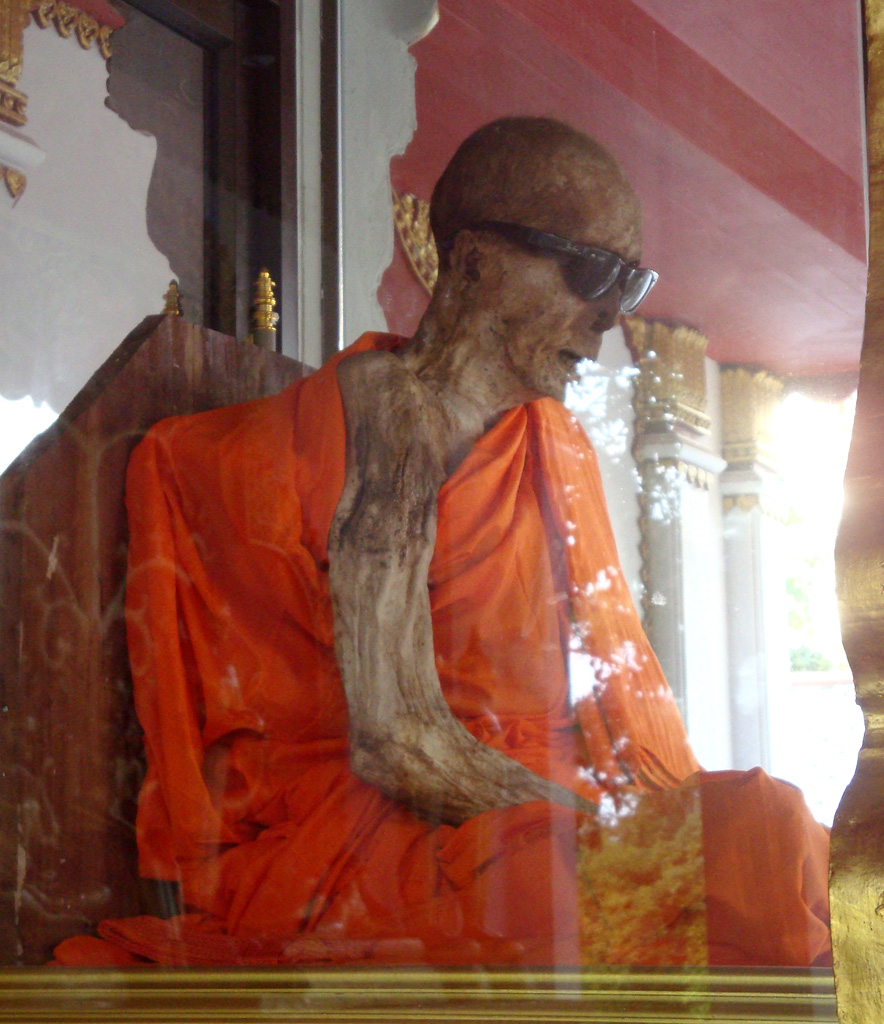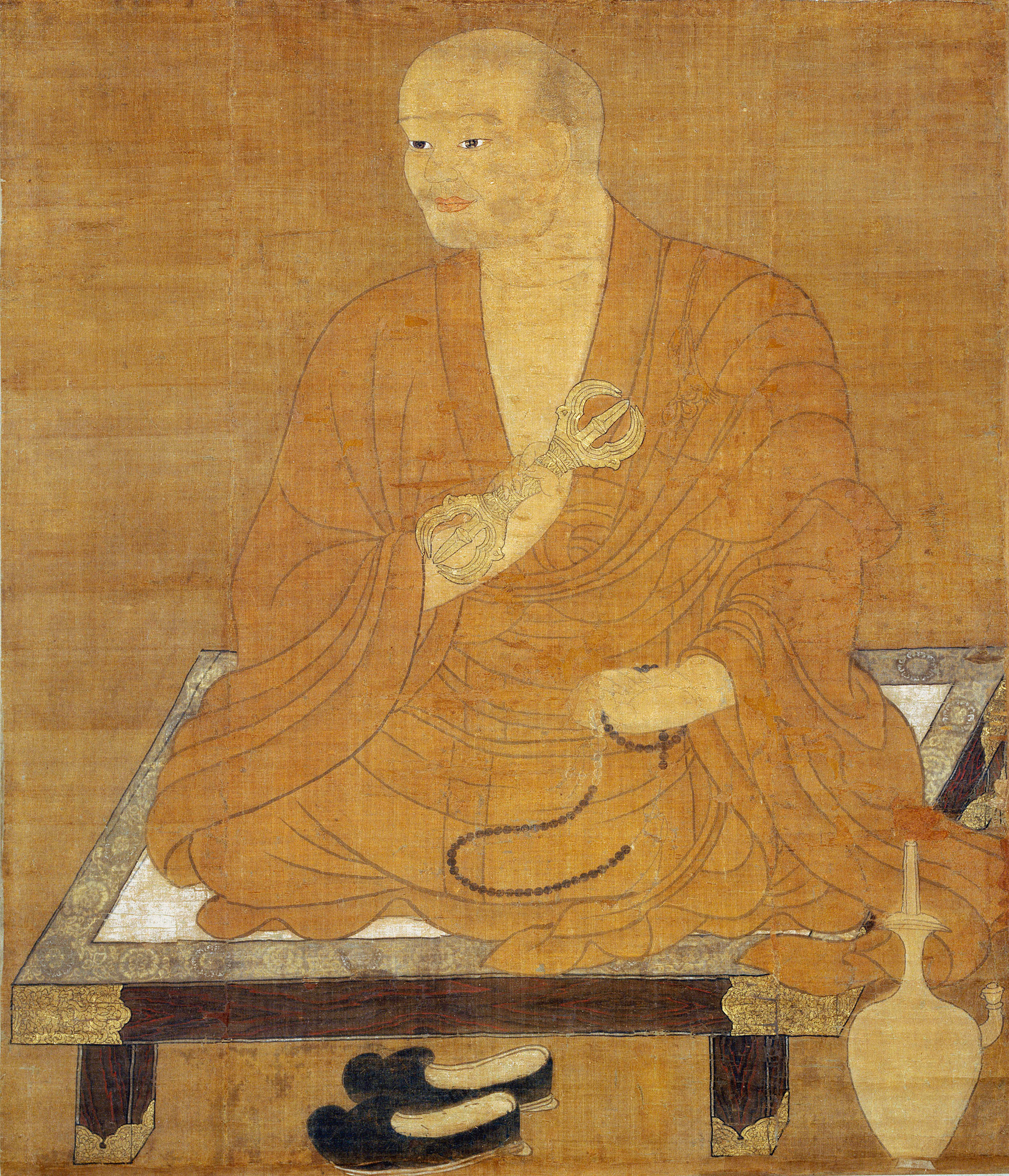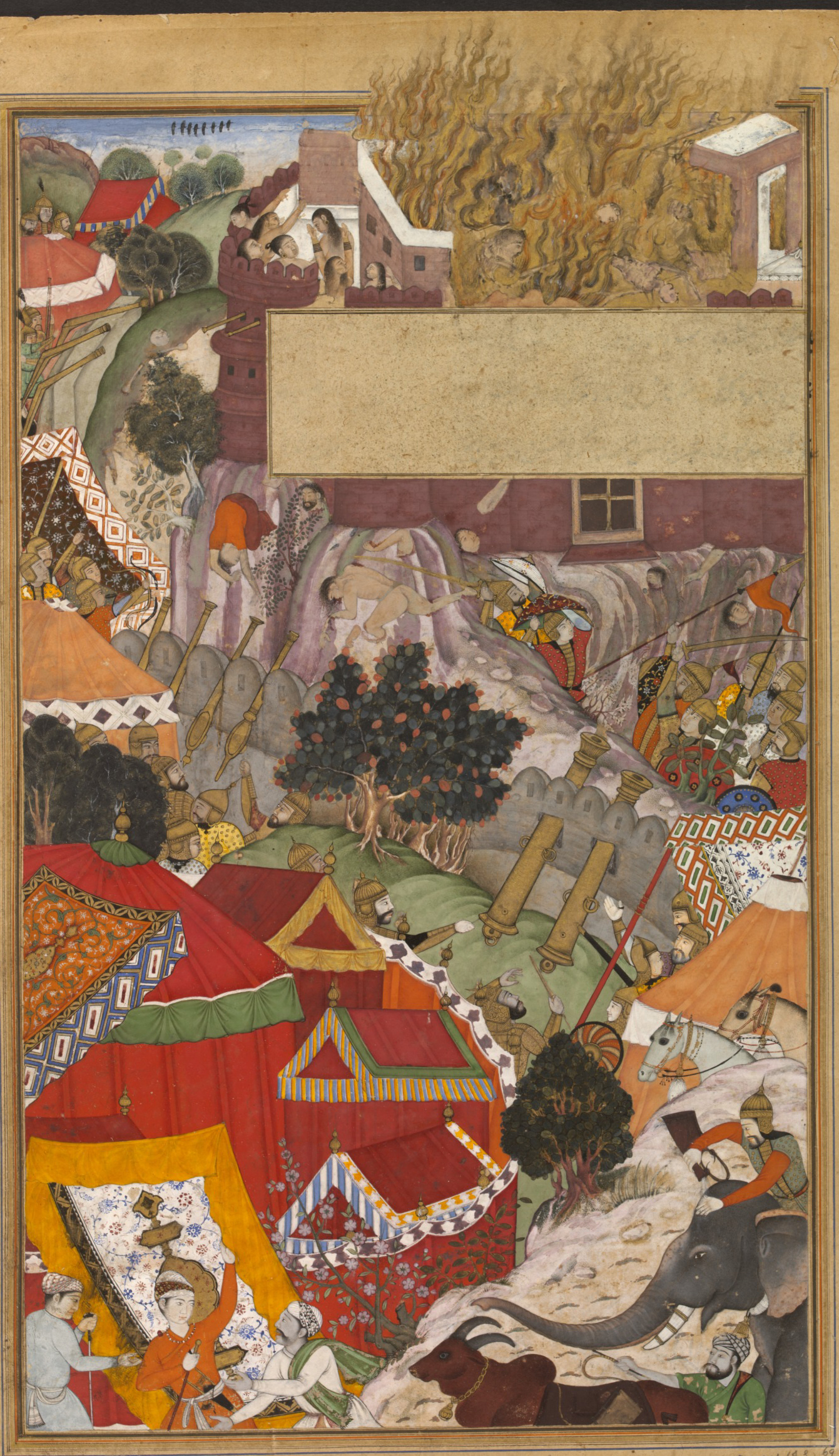|
Sokushinbutsu
are a kind of Buddhist mummy. In Japan the term refers to the practice of Buddhist monks observing asceticism to the point of death and entering mummification while alive. Mummified monks are seen in a number of Buddhist countries. Only in Japan are they believed to have induced their own death by starvation. Especially in South-Asian countries the monks die through natural causes after which their bodies are mummified. There is a common suggestion that Shingon school founder Kukai brought this practice from Tang China as part of secret tantric practices he learned. During the 20th century, Japanese scholars found very little evidence of self-starvation of Sokushinbutsu. They rather concluded that mummification took place after the demise of the monk practising this kind of asceticism. Origin There is at least one "self-mummified" 550-year-old corpse in existence: that of a Buddhist monk named Sangha Tenzin in a northern Himalayan region of India, visible in a temple in ... [...More Info...] [...Related Items...] OR: [Wikipedia] [Google] [Baidu] |
Buddhist Mummies
Buddhist mummies, also called flesh body bodhisattvas, full body sariras, or living buddhas (Sokushinbutsu) refer to the bodies of Buddhist monks and nuns that remain incorrupt, without any traces of deliberate mummification by another party. Many were destroyed or lost to history. In 2015, the Hungarian Natural History Museum exhibited a Buddhist mummy hidden inside a statue of Buddha, during its first tour outside China. Methods It is a common method in China. Some covered the bodies with clay or salt. According to Victor H. Mair in the Discovery Channel series ''The Mystery of the Tibetan Mummy'', the self-mummification of a Tibetan monk, who died ''ca.'' 1475 and whose body was retrieved relatively incorrupt in the 1990s, was achieved by the sophisticated practices of meditation, coupled with prolonged starvation and slow self-suffocation using a special belt that connected the neck with his knees in a lotus position. Ascetic monks (Sokushinbutsu) in Japan practiced ''nyūjō ... [...More Info...] [...Related Items...] OR: [Wikipedia] [Google] [Baidu] |
Asceticism
Asceticism (; from the el, ἄσκησις, áskesis, exercise', 'training) is a lifestyle characterized by abstinence from sensual pleasures, often for the purpose of pursuing spiritual goals. Ascetics may withdraw from the world for their practices or continue to be part of their society, but typically adopt a frugal lifestyle, characterised by the renunciation of material possessions and physical pleasures, and also spend time fasting while concentrating on the practice of religion or reflection upon spiritual matters. Various individuals have also attempted an ascetic lifestyle to free themselves from addictions, some of them particular to modern life, such as money, alcohol, tobacco, drugs, entertainment, sex, food, etc. Asceticism has been historically observed in many religious traditions, including Buddhism, Jainism, Hinduism, Islam, Christianity, Judaism, Stoicism and Pythagoreanism and contemporary practices continue amongst some religious followers. The practiti ... [...More Info...] [...Related Items...] OR: [Wikipedia] [Google] [Baidu] |
Shingon Buddhism
Shingon monks at Mount Koya is one of the major schools of Buddhism in Japan and one of the few surviving Vajrayana lineages in East Asia, originally spread from India to China through traveling monks such as Vajrabodhi and Amoghavajra. Known in Chinese as the Tangmi (; the Esoteric School in Tang Dynasty of China), these esoteric teachings would later flourish in Japan under the auspices of a Buddhist monk named Kūkai (), who traveled to Tang China to acquire and request transmission of the esoteric teachings. For that reason, it is often called Japanese Esoteric Buddhism, or Orthodox Esoteric Buddhism. The word ''shingon'' is the Japanese reading of the Chinese word ('), which is the translation of the Sanskrit word ("mantra"). History Shingon Buddhist doctrine and teachings arose during the Heian period (794-1185) after a Buddhist monk named Kūkai traveled to China in 804 to study Esoteric Buddhist practices in the city of Xi'an (), then called Chang-an, at ... [...More Info...] [...Related Items...] OR: [Wikipedia] [Google] [Baidu] |
Mummification
A mummy is a dead human or an animal whose soft tissues and organs have been preserved by either intentional or accidental exposure to chemicals, extreme cold, very low humidity, or lack of air, so that the recovered body does not decay further if kept in cool and dry conditions. Some authorities restrict the use of the term to bodies deliberately embalmed with chemicals, but the use of the word to cover accidentally desiccated bodies goes back to at least 1615 AD (see the section Etymology and meaning). Mummies of humans and animals have been found on every continent, both as a result of natural preservation through unusual conditions, and as cultural artifacts. Over one million animal mummies have been found in Egypt, many of which are cats. Many of the Egyptian animal mummies are sacred ibis, and radiocarbon dating suggests the Egyptian Ibis mummies that have been analyzed were from time frame that falls between approximately 450 and 250 BC. In addition to the mummies of ... [...More Info...] [...Related Items...] OR: [Wikipedia] [Google] [Baidu] |
Shingon
file:Koyasan (Mount Koya) monks.jpg, Shingon monks at Mount Koya is one of the major schools of Buddhism in Japan and one of the few surviving Vajrayana lineages in East Asia, originally spread from India to China through traveling monks such as Vajrabodhi and Amoghavajra. Known in Chinese as the Tangmi (; the Esoteric School in Tang Dynasty of China), these esoteric teachings would later flourish in Japan under the auspices of a Buddhist monk named Kūkai (), who traveled to Tang China to acquire and request transmission of the esoteric teachings. For that reason, it is often called Japanese Esoteric Buddhism, or Orthodox Esoteric Buddhism. The word ''shingon'' is the Kan-on, Japanese reading of the Traditional Chinese characters, Chinese word ('), which is the translation of the Sanskrit word ("mantra"). History Shingon Buddhist doctrine and teachings arose during the Heian period (794-1185) after a Buddhist monk named Kūkai traveled to China in 804 to study Esote ... [...More Info...] [...Related Items...] OR: [Wikipedia] [Google] [Baidu] |
Shugendō
is a highly syncretic religion, a body of ascetic practices that originated in the Nara Period of Japan having evolved during the 7th century from an amalgamation of beliefs, philosophies, doctrines and ritual systems drawn from local folk-religious practices, Shinto mountain worship and Buddhism. The final purpose of ''Shugendō'' is for practitioners to find supernatural power and save themselves and the masses by conducting religious training while treading through steep mountain ranges. Practitioners are called or . The mountains where ''shugenja'' practiced were all over Japan, and include various mountains of the Ōmine mountain range such as Mount Hakkyō and Mount Ōmine. The ''Shugendō'' worldview includes a large pantheon of deities (which include Buddhist and Shinto figures). Some of the most important figures are the tantric Buddhist figures of Fudō Myōō and Dainichi Nyorai. Other key figures are , which are considered to be the manifestation of Buddhas ... [...More Info...] [...Related Items...] OR: [Wikipedia] [Google] [Baidu] |
Sangha Tenzin
Lama Sangha Tenzin was a Buddhist monk. He is thought to have died in the 1500s. His remains are preserved as a mummy, which was discovered in 1975 in Gue, a small town in the Indian state of Himachal Pradesh. Tenzin's tomb was established in the village near the Line of Actual Control (LOC) in the Spiti Valley. His body is the only mummy of a Buddhist monk in India that was naturally mummified (self-mummification). However, the mummy was buried in an earthquake, leading the body to be rediscovered by ITBP personnel in 2004 when they were constructing roads in the area. When found, the body was naturally preserved in a thick glass box without the use of chemical preservatives. Originally from Tibet, Sangha Tenzin came to Gue for meditation when he was 45-years old. Folklore According to local folklore, Tenzin sacrificed his life for the survival of the village from scorpions. Legend says the mummy is alive and hence became known as "living Buddha". Legend claims that the hair ... [...More Info...] [...Related Items...] OR: [Wikipedia] [Google] [Baidu] |
Vajrayana
Vajrayāna ( sa, वज्रयान, "thunderbolt vehicle", "diamond vehicle", or "indestructible vehicle"), along with Mantrayāna, Guhyamantrayāna, Tantrayāna, Secret Mantra, Tantric Buddhism, and Esoteric Buddhism, are names referring to Buddhism, Buddhist traditions associated with Tantra and "Secret Mantra", which developed in the Medieval India, medieval Indian subcontinent and spread to Tibet, Nepal, other Himalayan states, East Asia, and Mongolia. Vajrayāna practices are connected to specific lineages in Buddhism, through the teachings of lineage holders. Others might generally refer to texts as the Buddhist Tantras. It includes practices that make use of mantras, dharanis, mudras, mandalas and the visualization of deities and Buddhas. Traditional Vajrayāna sources say that the tantras and the lineage of Vajrayāna were taught by Gautama Buddha, Śākyamuni Buddha and other figures such as the bodhisattva Vajrapani and Padmasambhava. Contemporary historians of Bu ... [...More Info...] [...Related Items...] OR: [Wikipedia] [Google] [Baidu] |
Self-immolation
The term self-immolation broadly refers to acts of altruistic suicide, otherwise the giving up of one's body in an act of sacrifice. However, it most often refers specifically to autocremation, the act of sacrificing oneself by setting oneself on fire and burning to death. It is typically used for political or religious reasons, often as a form of non-violent protest or in acts of martyrdom. It has a centuries-long recognition as the most extreme form of protest possible by humankind. Etymology The English word '' immolation'' originally meant (1534) "killing a sacrificial victim; sacrifice" and came to figuratively mean (1690) "destruction, especially by fire". Its etymology was from Latin "to sprinkle with sacrificial meal (mola salsa); to sacrifice" in ancient Roman religion. ''Self-immolation'' was first recorded in Lady Morgan's ''France'' (1817). Effects Self-immolators frequently use accelerants before igniting themselves. This, combined with the self-immolators' refusal ... [...More Info...] [...Related Items...] OR: [Wikipedia] [Google] [Baidu] |
Fayu Temple
Fayu Temple (), also called Stone Temple, is one of three major temples in Mount Putuo, Zhejiang, China. Its grand hall was rebuilt in 1699 during the Qing dynasty (1644–1911). History Fayu Temple is the second largest temple in Mount Putuo, and a national key Buddhist temple designated by the State Council. In 1580 during the Ming dynasty (1368–1644), a monk of Macheng, named Dazhi Zhenrong (), came from western Sichuan to Mount Putuo for training. He was attracted by the local scenery and built a small sanctuary named "Ocean Tide", meaning "Buddhist Ocean Guanyin". In 1594, the governor Wu Anguo renamed it "Ocean Tide Temple" (). It was destroyed by fire in 1598. In 1605, it was renovated and expanded. In the following year, the central government granted a plaque "National Defense Ocean Pacifying Temple" (), as well as an inscription called "Dragon Treasure". It suffered through several wars and fire. In 1687 during the Qing dynasty (1644–1911), the templ ... [...More Info...] [...Related Items...] OR: [Wikipedia] [Google] [Baidu] |
Bodhisattva
In Buddhism, a bodhisattva ( ; sa, 𑀩𑁄𑀥𑀺𑀲𑀢𑁆𑀢𑁆𑀯 (Brahmī), translit=bodhisattva, label=Sanskrit) or bodhisatva is a person who is on the path towards bodhi ('awakening') or Buddhahood. In the Early Buddhist schools as well as modern Theravada Buddhism, a bodhisattva (Pali: ''bodhisatta'') refers to someone who has made a resolution to become a Buddha and has also received a confirmation or prediction from a living Buddha that this will be so. In Mahayana Buddhism, a bodhisattva refers to anyone who has generated ''bodhicitta'', a spontaneous wish and compassionate mind to attain Buddhahood for the benefit of all sentient beings. Mahayana bodhisattvas are spiritually heroic persons that work to attain awakening and are driven by a great compassion (''mahakaruṇā''). These beings are exemplified by important spiritual qualities such as the "four divine abodes" (''brahmaviharas'') of loving-kindness ('' metta''), compassion (''karuṇā''), empathet ... [...More Info...] [...Related Items...] OR: [Wikipedia] [Google] [Baidu] |
:Category:Japanese Words And Phrases ...
{{Commons Words and phrases by language Words Words Words A word is a basic element of language that carries an objective or practical meaning, can be used on its own, and is uninterruptible. Despite the fact that language speakers often have an intuitive grasp of what a word is, there is no conse ... [...More Info...] [...Related Items...] OR: [Wikipedia] [Google] [Baidu] |





_(8697431158).jpg)

